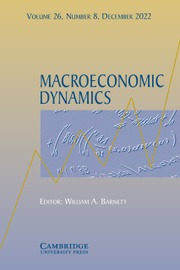No CrossRef data available.
Article contents
CREDIT FRICTIONS AND OPTIMAL LABOR-INCOME TAXATION
Published online by Cambridge University Press: 25 January 2018
Abstract
This paper studies optimal labor-income taxation in a simple model with credit constraints on firms. The labor-income tax rate and the shadow value on the credit constraint induce a wedge between the marginal product of labor and the marginal rate of substitution between labor and consumption. It is found that optimal policy prescribes a volatile path for the labor-income tax rate even in the presence of state-contingent debt and capital. In this respect, credit frictions are akin to a form of market incompleteness. Credit frictions break the equivalence between tax smoothing and wedge smoothing; therefore, as the tightness of the credit constraint varies over the business cycle, tax volatility is needed in order to counter this variation and, as a result, allow for wedge smoothing.
Information
- Type
- Articles
- Information
- Copyright
- Copyright © Cambridge University Press 2018
Footnotes
I am grateful to William A. Barnett (the editor), the associate editor and two anonymous referees for very invaluable comments and suggestions.

